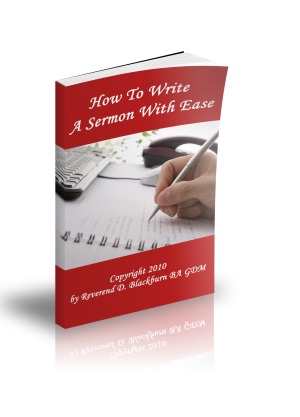|
| |||
How To Prepare A Sermon OutlineHow To Prepare A Sermon Outline is a brief overview of how to prpare sermon outlines for your preaching sermons. Master the process of sermon outlining and you will save time preparing sermons! 
How To Prepare A Sermon OutlineRegardless of how you prepare a sermon outline, there is one over-riding truth that will save you time preparing sermons. That is, a sermon has three parts - an introduction, a body and the conclusion. The body of your sermon is your sermon outline. Once you have completed your sermon outline and added content to your sermon outline, you then write the introduction and conclusion. 1. Sermon Outlines Have StructureWhen you preach two or three sermons a week, you will soon learn to structure your sermon outlines. Otherwise, you will never survive the ministry. You must develop a paradigm for preparing sermons and sermon outlines. Most preachers structure their sermons deductively. However, more and more ministers are learning the inductive method to sermon outlining. And others tend to have a bit of both. What is your paradigm for structuring your sermon outlines? 2. Sermon Outlines Have A Main Preaching Point (Topic)A sermon outline begins with the main preaching point or the topic of your sermon. Once you have your main preaching point, you then add sub-points and incidental points. The sub-points expand and explain the main preaching point and the incidental points expand and explain the sub-points. I will give you an example below of how you put this altogether. 3. Sermon Outlines (Especially Deductive) Have A Hinge WordYou are going to preach Romans 13:8-10. After studying the passage for some time, you decide that the main preaching point is Servicing The Debt of Love. Now that you have your main preaching point, you will need to find out what the passage is saying about the main preaching point. You discover that the passage is saying that the debt of love is continuous, practical and noble. Your sermon outline may begin to look like this. Servicing the Debt of Love
Now you need to find a HINGE word to swing the sub-points from the main preaching point. The HINGE word must be a plural noun. When the sub-points expand and explain the main preaching point, they usually answers the what, when, where, why or how question of the main preaching point. You will find that the sub-points answer the why question. That is, the reason why we should service the debt of love is because it is continuous, practical and noble. Therefore, your HINGE word would be Reasons. There are three REASONS why we need to service the debt of love. They are...
Now you have sequence and flow to your sermon outline. What you need to do next is add any incidental points. There are three REASONS why we need to service the debt of love. They are...

The incidental points need a hinge word also. This will help with sequence and flow to your sermon. 4. Sermon Outlines Have ContentOnce you have prepared the sermon outline, you need to add content and illustrations. Once you have written content to the sermon outline, you will need to write an introduction and a conclusion. |
SEARCH THIS SITE
|
||
 |
|||
|
Return to top
Homepage | Free Topical Sermons | Free Expository Sermons | Free Evangelistic Sermons | Free Christmas Sermons Free Easter Sermons | Free Mothers Day Sermons | Free Short Sermons | Free Sermonettes | Free Wedding Messages Free Sermons For Young People | Free Sermons For Youth | Free Sermons For Children | Free Online Sermons Free Sermon Outlines | Free Sermon Illustrations | Sermons Sermons Sermons | How To Write A Sermon | How To Write A Sermon Outline Writing A Funeral Sermon | Web Builders For Churches | Web Hosting For Churches | Web Design For Churches | Web Pages For Churches Web Keywords For Churches | Google Adsense For Churches | Site Map Disclaimer/Disclosure | Sermon Information |
|||
|
© Copyright 2008 -
All Rights Reserved No reproduction permitted without permission www.more-free-online-sermons.com How To Prepare A Sermon Outline | |||


